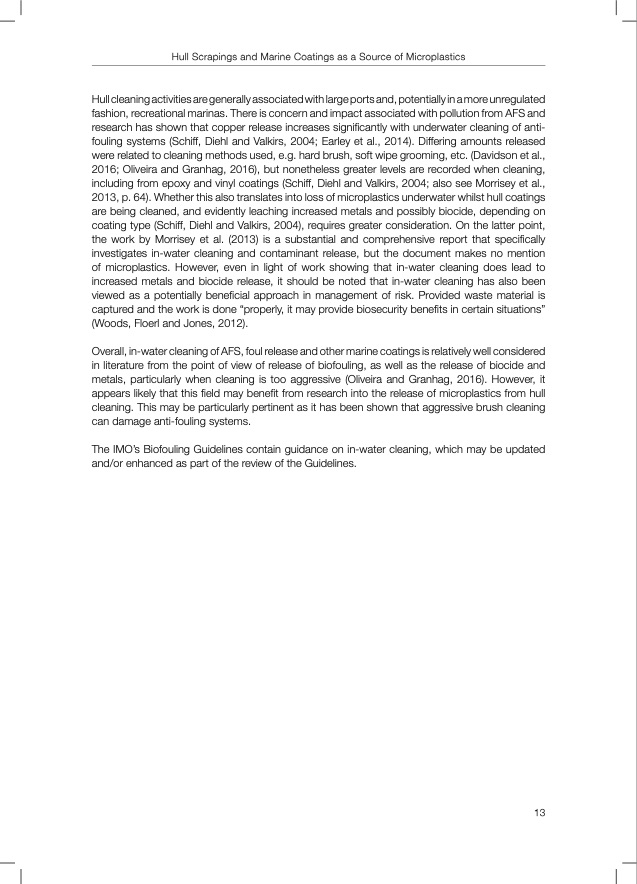
PDF Publication Title:
Text from PDF Page: 022
Hull Scrapings and Marine Coatings as a Source of Microplastics Hull cleaning activities are generally associated with large ports and, potentially in a more unregulated fashion, recreational marinas. There is concern and impact associated with pollution from AFS and research has shown that copper release increases significantly with underwater cleaning of anti- fouling systems (Schiff, Diehl and Valkirs, 2004; Earley et al., 2014). Differing amounts released were related to cleaning methods used, e.g. hard brush, soft wipe grooming, etc. (Davidson et al., 2016; Oliveira and Granhag, 2016), but nonetheless greater levels are recorded when cleaning, including from epoxy and vinyl coatings (Schiff, Diehl and Valkirs, 2004; also see Morrisey et al., 2013, p. 64). Whether this also translates into loss of microplastics underwater whilst hull coatings are being cleaned, and evidently leaching increased metals and possibly biocide, depending on coating type (Schiff, Diehl and Valkirs, 2004), requires greater consideration. On the latter point, the work by Morrisey et al. (2013) is a substantial and comprehensive report that specifically investigates in-water cleaning and contaminant release, but the document makes no mention of microplastics. However, even in light of work showing that in-water cleaning does lead to increased metals and biocide release, it should be noted that in-water cleaning has also been viewed as a potentially beneficial approach in management of risk. Provided waste material is captured and the work is done “properly, it may provide biosecurity benefits in certain situations” (Woods, Floerl and Jones, 2012). Overall, in-water cleaning of AFS, foul release and other marine coatings is relatively well considered in literature from the point of view of release of biofouling, as well as the release of biocide and metals, particularly when cleaning is too aggressive (Oliveira and Granhag, 2016). However, it appears likely that this field may benefit from research into the release of microplastics from hull cleaning. This may be particularly pertinent as it has been shown that aggressive brush cleaning can damage anti-fouling systems. The IMO’s Biofouling Guidelines contain guidance on in-water cleaning, which may be updated and/or enhanced as part of the review of the Guidelines. 13PDF Image | HULL SCRAPINGS AND MARINE COATINGS AS A SOURCE OF MICROPLASTICS

PDF Search Title:
HULL SCRAPINGS AND MARINE COATINGS AS A SOURCE OF MICROPLASTICSOriginal File Name Searched:
Hull-Scrapings-report.pdfDIY PDF Search: Google It | Yahoo | Bing
Development of a solar powered Electric Ship The Electricship website originally started off as a project to develop a comprehensive renewable, affordable, modular electric ship... More Info
Modular Boat Hull Composite The case for a unsinkable, modular composite hybrid boat hull... More Info
MS Burgenstock Hybrid Electric Catamaran Lake Lucerne Unique shuttle servicing Lucerne to the Burgenstock Resort... More Info
Ground Power Unit GPU Powered by Lithium Ion Batteries The goal of the Ground Power Unit is to provide a readily accessible, modular, ready-to-power solution for remote power... More Info
| CONTACT TEL: 608-238-6001 Email: greg@electricship.com | RSS | AMP |